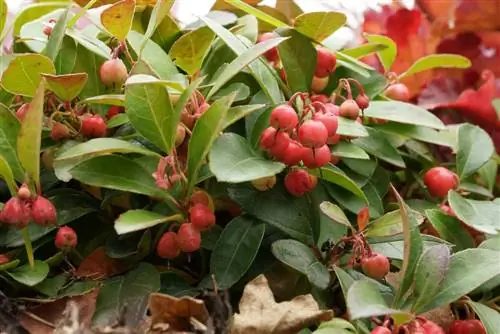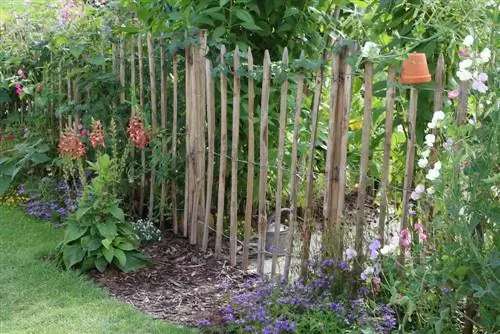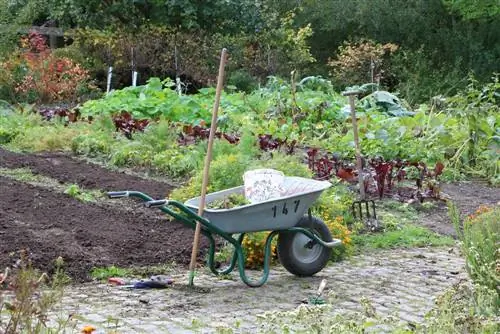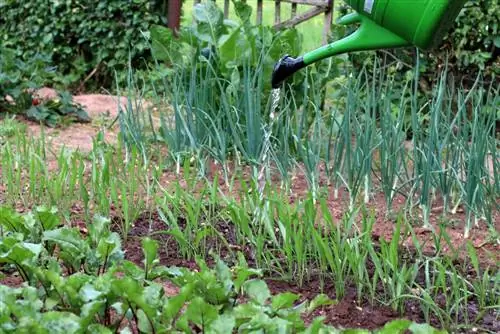- Author admin [email protected].
- Public 2023-12-17 03:39.
- Last modified 2025-06-01 06:48.
Mockberries (Gaultheria) are usually low-growing evergreen shrubs. The Gaultheria fragrantissima variety, which comes from the Himalayas, is also known as a small tree and reaches heights of between 5 and 6 meters. We give care tips for all mock berry varieties.
Mockberry - profile
- upright to creeping branches
- green leaves that give off an aromatic scent when crushed
- raceme-like inflorescences
- white, cream or pink flowers
The capsule fruits present on the false berry are spherical and fleshy, which is why they are also called berries and hence the plant gets its name. They can be red or blue, and in some varieties even white. In total, up to 135 different species of the false berry are known.
The flowers of the false berry are arranged singly or up to twelve on inflorescences that are grown together like grapes. The mock berry is also used as a medicinal plant. The leaves are particularly used against rheumatic diseases or nerve pain. In America it is even used to make tea. The leaves smell like chewing gum when crushed, which is why the chewing gum industry uses them as a flavoring agent. The so-called evergreen oil (wintergreen) is also obtained from the plant, which is also used in toothpaste.
The leaves of the mock berry have a short stem and sit on a stem. They can also be formed in different shapes and colors and represent another attractive point of the plant. The flowers of the Shallon berry (Gaultheria shallon) look like the flowers of the bleeding heart or like small bells. Due to the multitude of variations, not only garden areas can be covered in green and provided with attractive contrasts. As a single plant or as a group planting, the Gaultheria varieties are an eye-catcher in the garden.
The most famous varieties
The countries of origin of the mock berry are North and South America, India, Australia and also New Zealand. Some of them come from the Far Eastern part of the world, such as Japan or the Himalayas. The false berry is also known as the partridge berry.
Attention
The berries of the mockberry are classified as slightly poisonous and cause vomiting!
In the garden, the mock berry finds its place either as a colorful autumn and winter plant and creates colorful splashes of color in an autumn garden with its colored leaves and beautiful red, blue or white berries. If it is planted as a low variant, it can be referred to as a ground cover or as a carpet berry (Gaultheria procumbens).
Location in the garden
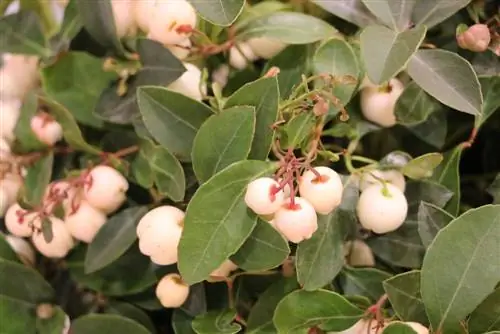
If the mock berry is planted in the garden, it needs a place that is in sun to partial shade. It should be as bright as possible so that many new flowers and berries will be formed. The soil should not dry out for the mock berry, it does not like drought at all. On the other hand, if she gets really wet feet at times, it doesn't bother her at all. A portion of mulch should protect them from drying out in the garden. If it is planted in ericaceous soil or rhododendron soil, the soil should also have a pH value in the acidic range.
Tip:
Fertilize once a month without lime from spring to August.
The mock berry should no longer be fertilized after August. During this time it is said to become woody; if it were further fertilized, it would continue to grow instead. If it does not woody, it is sensitive to frost. She can find a nice place under trees where she likes to close the gaps in the planting. However, their slow growth is not for impatient gardeners.
When cultivated in the garden, the false berry forms underground runners, which causes it to multiply. However, this happens very slowly; it has a growth rate of 10 cm per year. Nevertheless, the plants should be spaced half a meter apart. If the false berry is cut back before flowering, the time of flowering can be delayed. In this way, the beautiful time of the red berries can be extended or varied, for example if several groups have been planted in the garden.
Tip:
Birds don't like the berries of the blackberry, but bumblebees especially love them.
potted plant
The mock berry plays a special role in autumnal decorations. Thanks to the beautiful play of colors of the leaves and the different berry colors, it is exactly the right plant for an autumn flower pot or a balcony box. It is hardy, so it can survive frosts and could practically become a permanent resident. The mock berry is often used for decoration outside, especially before Christmas. It is robust and at the same time very decorative, its small red berries look like small Christmas balls and therefore decorate festive arrangements on the stairs to the house.
What you should know in brief
- There are a variety of other names for the mock berry. For example, it is also known under the names prostrate false berry, prostrate partridge berry, fruity cranberry, American wintergreen or wintergreen shrub.
- The mock berry only grows to around 15 centimeters high and is up to 50 centimeters wide. That's why it is often used as a ground cover.
- It is a heather and ericaceous plant and has similar requirements as the heather. The soil should be acidic and moist. The location is shady to semi-shady.
- As fertilizer, the mock berry needs temporary amounts of peat and occasional mineral or organic mixtures.
- The plant is very sensitive to drought, so it needs a sufficient supply of water if it persists.
- On the other hand, it is frost hardy. In winter it decorates your garden with bronze-red foliage and beautiful fruits.
The false berry blooms with light pink to white flowers in July and August and then produces small, red berries until spring, which some claim are edible, while the poison control center warns of their toxicity. Heather herbs, which also include the mock berry, should always be planted together in larger groups.
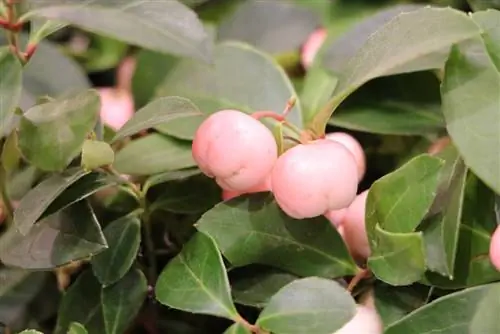
The advantage here is that the adult plants form coherent stands and therefore there is no room for weeds.
The mock berry can be cut back between mid-March and mid-April. This promotes growth and bud formation in the coming summer.
Pruning generally results in later flowering. You can use this to your advantage and get different flowering times by cutting at different times. This means that the flowering period of the area can be extended and you can enjoy the splendor of your flowering berries for longer.

